Guozhong Cao. Nanostructures & Nanomaterials: Synthesis, Properties & Applications
Подождите немного. Документ загружается.


296
Nanostructures and Nanomaterials
acoustic microscope are also members of SPM.66 SPM has proved its suit-
ability in various fields of applications. First, SPM is capable of imaging the
surface of all kinds of solids virtually under any kind of environment.
Secondly, with various modifications of tips and operating conditions, SPM
can be used to measure local chemical and physical properties of sample
surface. Thirdly,
SPM
has been explored as a useful tool in nano-manipula-
tion and nanolithography in fabrication and processing of nanostructures.
Fourthly, SPM has also been investigated as various nanodevices, such as
nanosensors and nanotwizers. In this chapter, our discussion will be focused
only on the applications of SPM on nano-manipulation and fabrication of
nanostructures as well as the surface chemistry modification. Imaging of
surface topography and surface property measurements will be discussed in
Chapter
8,
whereas the nanodevices derived fiom SPM will be one of the
subjects of discussion in Chapter 9.
7.3.3.
Near-field scanning optical microscopy (NSOM)
The concept of near-field scanning for imaging purposes using
3
cm
microwaves was first studied in 1 97267 and near-field optical microscopy
was first developed early in 1980~.@,~~ In
NSOM,
a resolution of -30nm
is a~hievable.~~ NSOM has been used as a tool for photolithography on the
submicron length scale. In this application, the fiber optical probe is used
as a light source to expose a photoresist, and patterns are generated by
scanning the probe over the resist surface. Patterns on conventional poly-
mer resists, amorphous silicon photoresists, and ferroelectric surfaces
have been dem~nstrated.~'-~~
In NSOM, the incident radiation is forced through a subwavelength
aperture. In terms of wave propagation theory, this is only possible by for-
mation of wavelets with wavelengths similar to the aperture diameter. The
latter is known as evanescent waves and cannot propagate in free space.
However, they can wind themselves around the aperture and therefore,
transmit radiative energy to the other side of the screen. Such a radiation
on the other side of the screen varies significantly with the distance from
the screen, and three zones of energy density can be distinguished as shown
in Fig. 7.12.75 Next to the aperture, within a proximity sheet of
2-5
nm, the
intensity stays nearly constant and has a relatively large value of the order
of
10-3-10-4.
This
is
the evanescent wave regime and an absorbing object
in this zone strongly influences the radiation from the aperture.
A
little
away from the aperture
(5-500 nm), the intensity decays approximately
proportional to where
s
is the distance from the aperture. This is the

Nunostructures Fabricated by Physical Techniques
297
tX
A
h
-11
-
0.01
I
10
100
Normalized
Distance
Fig.
7.12.
(a) Schematic showing lines of equal electrical-energy density near a
small
aperture.
(b)
Same for far field and equivalent dipoles. (c) Calculated on axis electrical-
energy density versus distance from aperture, magnetic excitation.
[U.
Diirig,
D.W.
Pohl,
and
F.
Rohner,
J:
Appl.
Phys.
59,
33
18
(1
986).]
zone where the evanescent waves evanesce, and is the better known part
of the near-field regime. In this regime, the energy density is already very
small and varies between and
lo-''.
Absorbing objects in this zone
have much less influence per unit volume on the evolving radiative field
than in the proximity zone. Further away from the aperture with a distance
larger than the wavelength, the radiation from the aperture enters the far-
field regime and the energy density decreases by
sP2.
The control of the
distance between tip and sample in the nanometer range, i.e. in the near-
field region, is crucial,
so
that the intensity of the evanescent wave
remains sufficient for the detection system.
The
NSOM
setup is similar to
AFM.
The ideal aperture
is
a transparent
hole in
a
thin perfectly conducting metal film at optical frequencies. In

298
Nanostructures and Nanomaterials
practice, typical apertures are made of optical fibers coated with a layer of
metal such as aluminum with a hole at the apex by chemical et~hing
or by pulling.78 The minimum feasible aperture and, thus, maximum
achievable resolution depend on the input power available and the sensi-
tivity of the detection system.
7.3.4.
Nanomanipulation
In addition to the ability of imaging surface topography at atomic resolution,
the interactions or forces between the tip and the sample surface offer a
means to carry out precise and controlled manipulation of atoms, molecules
and nanostructures on a surface. Photolithography is capable
of
fabricating
features of
200
nm and above.7 The following briefly outlines some exam-
ples of nanomanipulation and fabrication by STM.
Eigler and coworkers79 used pulse voltage applied via a STM tip to
move and place xenon atoms onto an orderly patterned structure. They did
this in ultrahigh vacuum and ultra low temperature. The low temperature
and ultrahigh vacuum provided the stability, cleanliness and absence of
thermal difision of atoms on surface. The tungsten tip was used to posi-
tion
35
xenon atoms onto a nickel surface to form three letters
“IBM”
as
shown in Fig.
7.13.79
Two processes have been identified for the manipu-
lation of atoms on a substrate surface, namely, parallel and perpendicular
processes.80 In a parallel process, the STM tip drags the atom along the sur-
face and positions the atom at a desired spot. In this process, the motion of
the manipulated adsorbed atom or molecule is parallel to the surface, and
the bond between the manipulated atom or molecule and the underlying
Fig.
7.13.
The tungsten tip was used to position
35
xenon atoms onto a nickel surface to
form
three letters
“IBM”.
[D.M.
Eigler and E.K. Schweizer,
Nature
344,
524
(1990).]
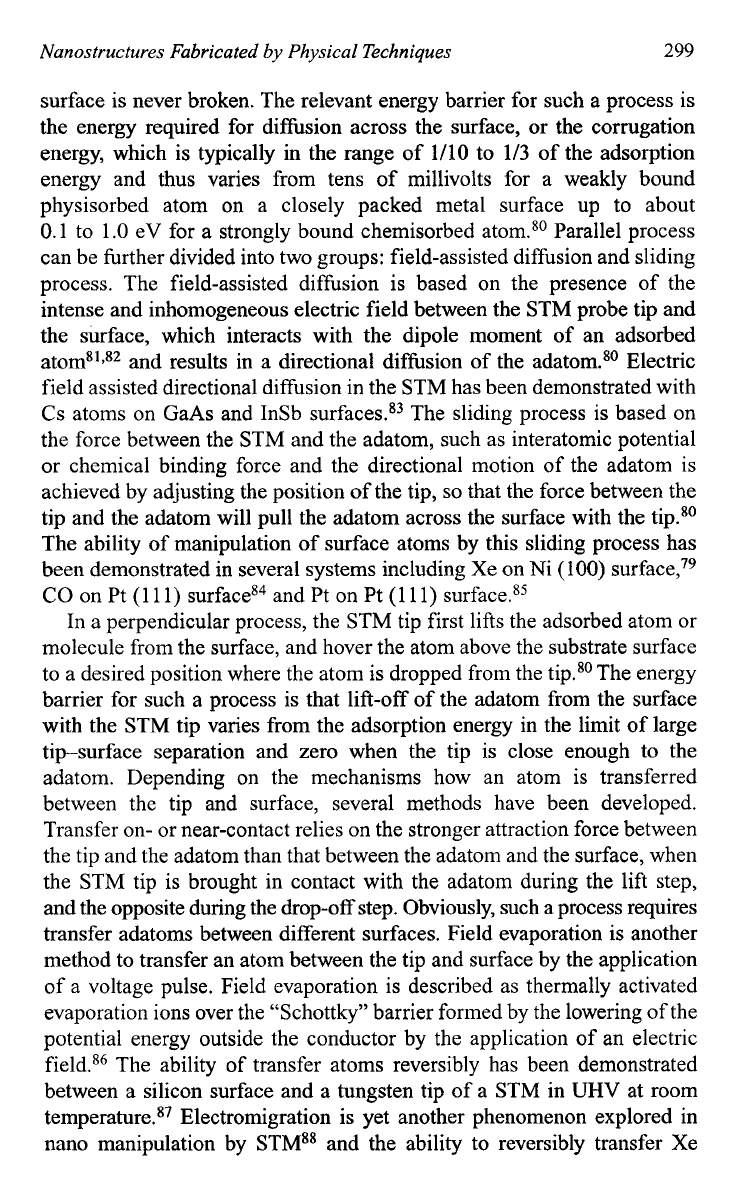
Nanostructures
Fabricated
by Physical
Techniques
299
surface is never broken. The relevant energy barrier for such a process is
the energy required for diffusion across the surface, or the corrugation
energy, which is typically in the range of 1/10 to
1/3
of
the adsorption
energy and thus varies from tens of millivolts for a weakly bound
physisorbed atom on a closely packed metal surface up to about
0.1
to
1
.O
eV for a strongly bound chemisorbed atom.80 Parallel process
can be further divided into two groups: field-assisted diffusion and sliding
process. The field-assisted diffusion is based on the presence of the
intense and inhomogeneous electric field between the STM probe tip and
the skface, which interacts with the dipole moment of an adsorbed
atom81,82 and results in a directional difhsion of the adatom.80 Electric
field assisted directional diffusion in the STM has been demonstrated with
Cs
atoms on GaAs and InSb surfaces.83 The sliding process is based on
the force between the STM and the adatom, such as interatomic potential
or chemical binding force and the directional motion of the adatom is
achieved by adjusting the position
of
the tip,
so
that the force between the
tip and the adatom will pull the adatom across the surface with the tip.80
The ability of manipulation of surface atoms by this sliding process has
been demonstrated in several systems including Xe on Ni
(100)
surface,79
CO
on Pt
(1 1
1)
surfaces4 and Pt on Pt (1 11) surface.85
In a perpendicular process, the STM tip first lifts the adsorbed atom or
molecule from the surface, and hover the atom above the substrate surface
to a desired position where the atom is dropped from the tip.80 The energy
barrier for such a process is that lift-off of the adatom from the surface
with the
STM
tip varies from the adsorption energy in the limit of large
tipsurface separation and zero when the tip is close enough to the
adatom. Depending on the mechanisms how an atom is transferred
between the tip and surface, several methods have been developed.
Transfer on- or near-contact relies on the stronger attraction force between
the tip and the adatom than that between the adatom and the surface, when
the STM tip is brought in contact with the adatom during the lift step,
and the opposite during the drop-off step. Obviously, such a process requires
transfer adatoms between different surfaces. Field evaporation is another
method to transfer an atom between the tip and surface by the application
of a voltage pulse. Field evaporation is described as thermally activated
evaporation ions over the "Schottky" barrier formed by the lowering of the
potential energy outside the conductor by the application of an electric
field.86 The ability
of
transfer atoms reversibly has been demonstrated
between a silicon surface and a tungsten tip of a STM in
UHV
at room
temperat~re.~~ Electromigration is yet another phenomenon explored in
nano manipulation by STMS8 and the ability to reversibly transfer Xe
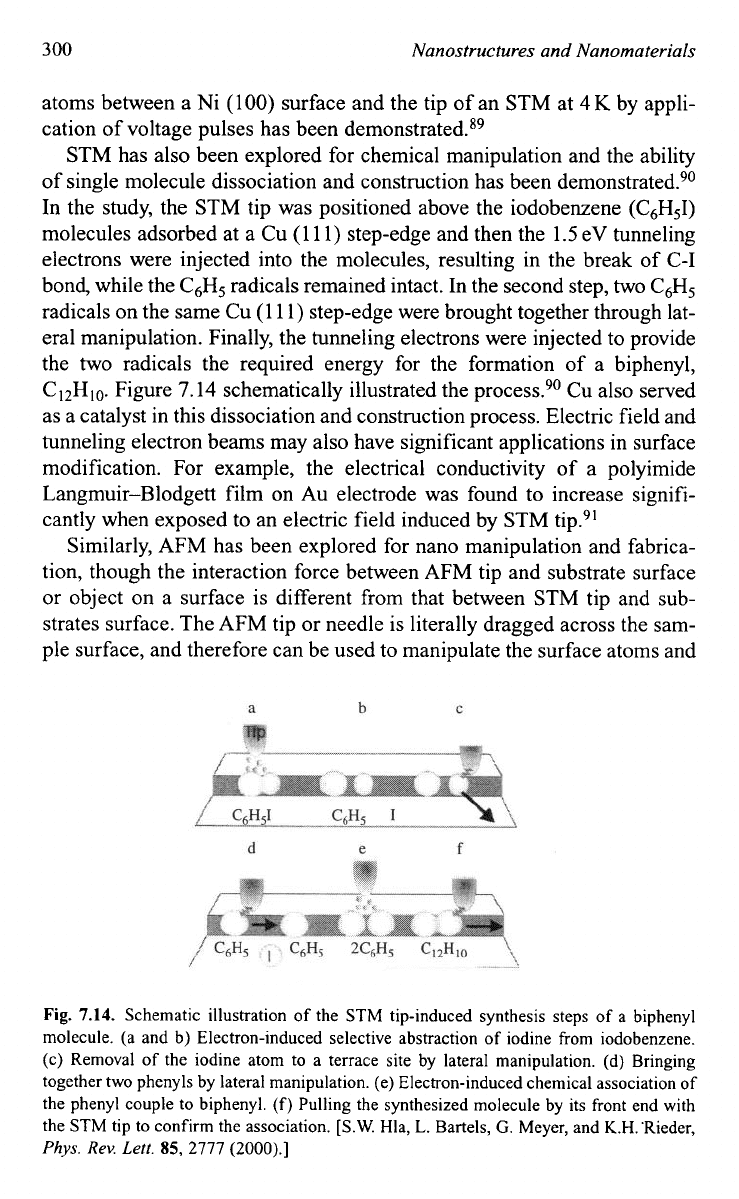
300
Nanostructures
and
Nanomaterials
atoms between a Ni (100) surface and the tip of an STM at 4
K
by appli-
cation of voltage pulses has been demon~trated.~~
STM has also been explored for chemical manipulation and the ability
of single molecule dissociation and construction has been demon~trated.~~
In
the study, the STM tip was positioned above the iodobenzene (C,H,I)
molecules adsorbed at a Cu
(1
1
1) step-edge and then the 1.5 eV tunneling
electrons were injected into the molecules, resulting in the break of C-I
bond, while the C6H5 radicals remained intact. In the second step, two C,H,
radicals on the same Cu (1 1 1) step-edge were brought together through lat-
eral manipulation. Finally, the tunneling electrons were injected to provide
the two radicals the required energy for the formation of a biphenyl,
CI2Hl0. Figure 7.14 schematically illustrated the process.90 Cu also served
as a catalyst in this dissociation and construction process. Electric field and
tunneling electron beams may also have significant applications in surface
modification. For example, the electrical conductivity of a polyimide
Langmuir-Blodgett film on Au electrode was found to increase signifi-
cantly when exposed to an electric field induced by STM
Similarly, AFM has been explored for nano manipulation and fabrica-
tion, though the interaction force between AFM tip and substrate surface
or object on a surface is different from that between STM tip and sub-
strates surface. The AFM tip or needle is literally dragged across the sam-
ple surface, and therefore can be used to manipulate the surface atoms and
Fig.
7.14.
Schematic illustration
of
the STM tip-induced synthesis steps
of
a
biphenyl
molecule. (a and b) Electron-induced selective abstraction
of
iodine from iodobenzene.
(c) Removal
of
the iodine atom to a terrace site by lateral manipulation. (d) Bringing
together two phenyls by lateral manipulation. (e) Electron-induced chemical association of
the phenyl couple to biphenyl.
(f)
Pulling the synthesized molecule by its front end with
the STM tip to confirm the association.
[S.W.
Hla,
L.
Bartels, G. Meyer, and K.H.'Rieder,
Phys.
Rev.
Lett.
85,
2777
(2000).]
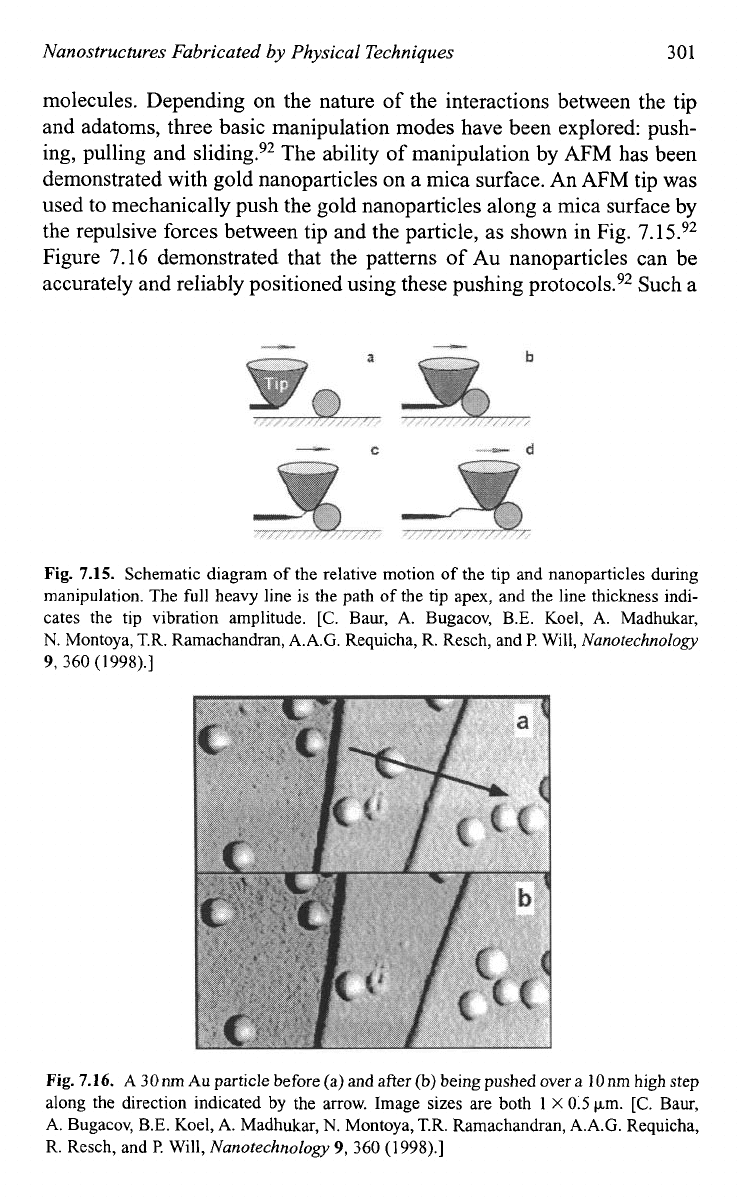
Nanostructures Fabricated
by
Physical Techniques
301
molecules. Depending on the nature of the interactions between the tip
and adatoms, three basic manipulation modes have been explored: push-
ing, pulling and sliding.92 The ability of manipulation by AFM has been
demonstrated with gold nanoparticles on a mica surface. An AFM tip was
used to mechanically push the gold nanoparticles along a mica surface by
the repulsive forces between tip and the particle, as shown in Fig.
7.15.92
Figure
7.16
demonstrated that the patterns of Au nanoparticles can be
accurately and reliably positioned using these pushing protocols.92 Such a
Fig.
7.15
Schematic diagram of the relative motion of the tip and nanoparticles during
manipulation. The full heavy line
is
the path of the tip apex, and the line thickness indi-
cates the tip vibration amplitude. [C. Baur,
A.
Bugacov, B.E. Koel,
A.
Madhukar,
N.
Montoya, T.R. Ramachandran,
A.A.G.
Requicha, R. Resch, and
P.
Will,
Nanotechnology
9,
360
(1998).]
Fig.
7.16.
A
30nm
Au
particle before (a) and after (b) being pushed over a
1
Onm high step
along the direction indicated by the arrow. Image sizes are both
1
X
0.5
km.
[C.
Baur,
A.
Bugacov, B.E. Koel,
A.
Madhukar,
N.
Montoya, T.R. Ramachandran,
A.A.G.
Requicha,
R. Resch, and
I?
Will,
Nanotechnology
9,
360
(1
998).]
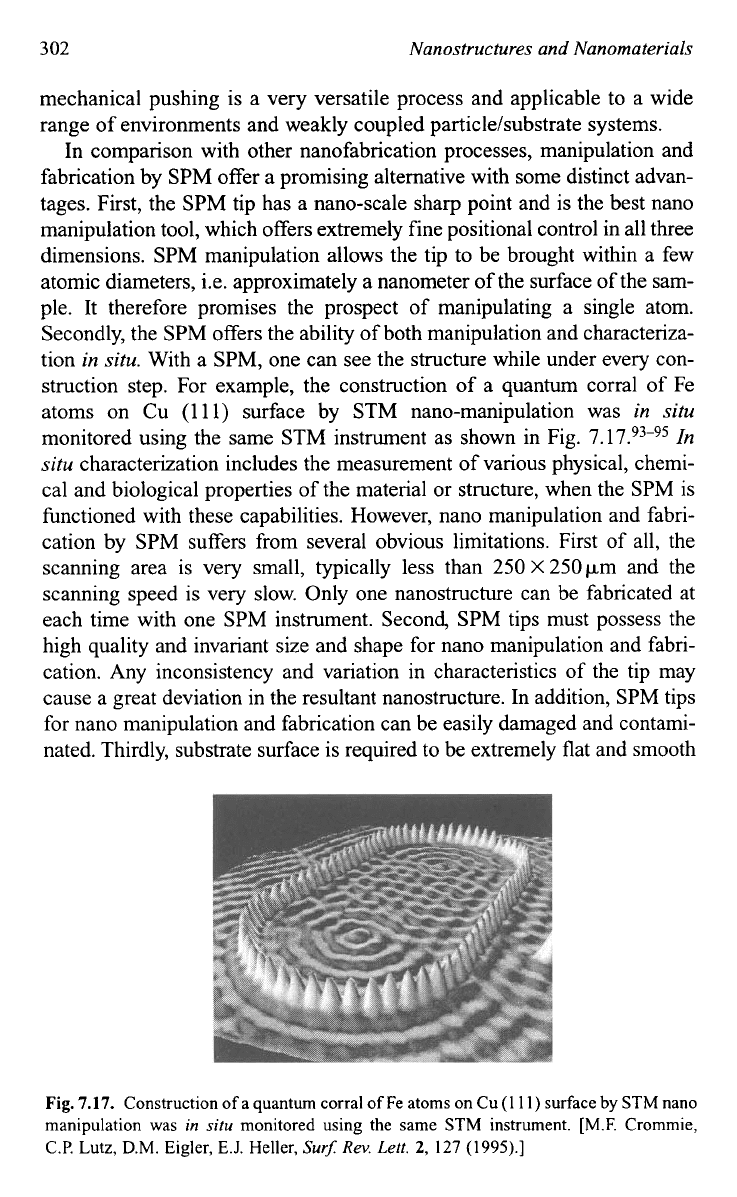
302
Nanostructures and Nanomaterials
mechanical pushing is a very versatile process and applicable to a wide
range of environments and weakly coupled particle/substrate systems.
In comparison with other nanofabrication processes, manipulation and
fabrication by SPM offer a promising alternative with some distinct advan-
tages. First, the SPM tip has
a
nano-scale sharp point and is the best nano
manipulation tool, which offers extremely fine positional control in all three
dimensions. SPM manipulation allows the tip to be brought within a few
atomic diameters, i.e. approximately a nanometer of the surface of the sam-
ple. It therefore promises the prospect of manipulating a single atom.
Secondly, the SPM offers the ability
of
both manipulation and characteriza-
tion
in
situ.
With a SPM, one can see the structure while under every con-
struction step. For example, the construction of a quantum corral of Fe
atoms on Cu (1 11) surface by STM nano-manipulation was
in situ
monitored using the same STM instrument as shown in Fig. 7.1 7.93-95
In
situ
characterization includes the measurement of various physical, chemi-
cal and biological properties of the material or structure, when the SPM is
fimctioned with these capabilities. However, nano manipulation and fabri-
cation by SPM suffers from several obvious limitations. First of all, the
scanning area is very small, typically less than
250
X
250
pm and the
scanning speed is very slow. Only one nanostructure can be fabricated at
each time with one SPM instrument. Second, SPM tips must possess the
high quality and invariant size and shape for nano manipulation and fabri-
cation. Any inconsistency and variation in characteristics of the tip may
cause a great deviation in the resultant nanostructure. In addition, SPM tips
for nano manipulation and fabrication can be easily damaged and contami-
nated. Thirdly, substrate surface is required to be extremely flat and smooth
Fig.
7.17.
Construction of a quantum corral
of
Fe atoms on Cu (1 11) surface
by
STM nano
manipulation was
in
situ
monitored using the same
STM
instrument. [M.F. Crornrnie,
C.P.
Lutz, D.M. Eigler, E.J. Heller,
SurJ
Rev.
Lett.
2,
127
(1
995).]
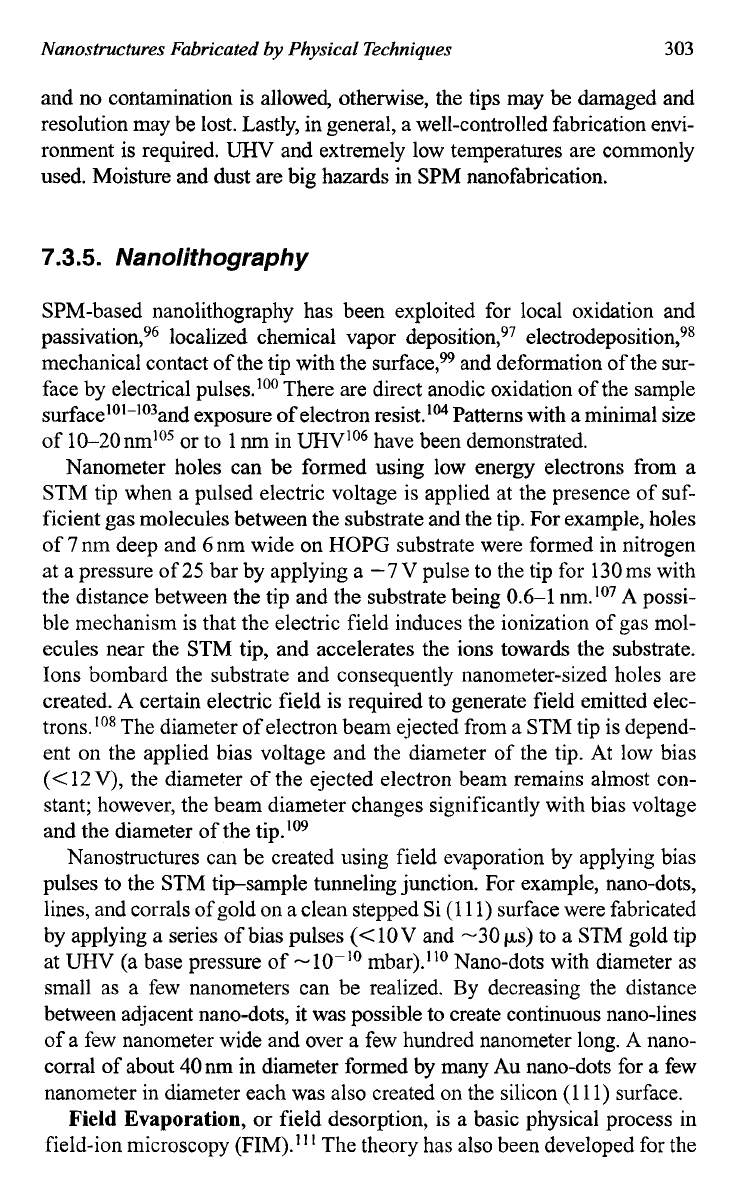
Nanostructures Fabricated
by
Physical Techniques
303
and no contamination is allowed, otherwise, the tips may be damaged and
resolution may be lost. Lastly, in general, a well-controlled fabrication envi-
ronment is required.
UHV
and extremely low temperatures are commonly
used. Moisture and dust are big hazards in SPM nanofabrication.
7.3.5.
Nanolifhograph
y
SPM-based nanolithography has been exploited for local oxidation and
passivation,96 localized chemical vapor depo~ition,~~ electrodeposition,98
mechanical contact of the tip with the surface,w and deformation of the sur-
face by electrical pulses.Io0 There are direct anodic oxidation
of
the sample
~urface'~'-'~~and exposure of electron resist.'@' Patterns with a minimal size
of
10-20
nm105 or to
1
nm in
UHVIo6
have been demonstrated.
Nanometer holes can be formed using low energy electrons from a
STM tip when a pulsed electric voltage is applied at the presence of suf-
ficient gas molecules between the substrate and the tip. For example, holes
of
7
nm deep and
6
nm wide on HOPG substrate were formed in nitrogen
at a pressure
of
25
bar by applying a
-7
V
pulse to the tip for
130
ms with
the distance between the tip and the substrate being
0.6-1
.,.Io7 A possi-
ble mechanism is that the electric field induces the ionization of gas mol-
ecules near the
STM
tip, and accelerates the ions towards the substrate.
Ions bombard the substrate and consequently nanometer-sized holes are
created. A certain electric field is required to generate field emitted elec-
trons.'08 The diameter of electron beam ejected from a STM tip is depend-
ent on the applied bias voltage and the diameter of the tip. At low bias
(<
12
V),
the diameter of the ejected electron beam remains almost con-
stant; however, the beam diameter changes significantly with bias voltage
and the diameter of the tip.'09
Nanostructures can be created using field evaporation by applying bias
pulses to the
STM
tipsample tunneling junction. For example, nano-dots,
lines, and corrals of gold on a clean stepped Si
(1
1
1)
surface were fabricated
by applying a series of bias pulses
(<
10
V
and
-30
ps)
to a STM gold tip
at
UHV
(a base pressure of
-
mbar).'I0 Nano-dots with diameter as
small as a few nanometers can be realized. By decreasing the distance
between adjacent nano-dots, it was possible to create continuous nano-lines
of a few nanometer wide and over a few hundred nanometer long.
A
nano-
corral of about
40
nm in diameter formed by many Au nano-dots for a few
nanometer in diameter each was also created on the silicon
(1
11)
surface.
Field
Evaporation,
or field desorption, is a basic physical process in
field-ion microscopy
(FIM).'
*
The theory has also been developed for the
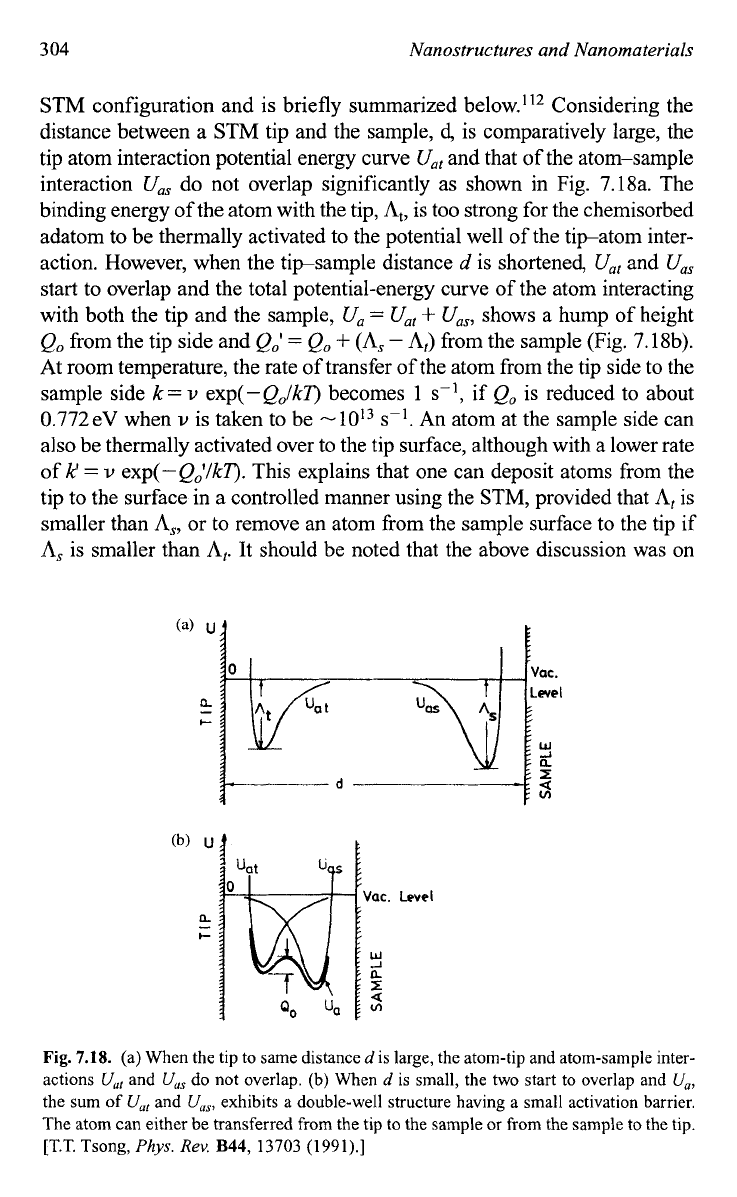
3
04
Nanostructures and Nanomaterials
STM configuration and is briefly summarized below.''* Considering the
distance between a STM tip and the sample,
d,
is comparatively large, the
tip atom interaction potential energy curve
U,,
and that of the atom-sample
interaction
U,,
do not overlap significantly as shown in Fig. 7.18a. The
binding energy of the atom with the tip,
A,,
is too strong for the chemisorbed
adatom to be thermally activated to the potential well of the tipatom inter-
action. However, when the tipsample distance
d
is shortened,
U,,
and
U,,
start to overlap and the total potential-energy curve of the atom interacting
with both the tip and the sample,
U,
=
U,,
+
U,,,
shows a hump of height
Q,
from the tip side and
Qo'
=
(3,
+
(A,
-
A,)
from the sample (Fig. 7.18b).
At room temperature, the rate of transfer of the atom from the tip side to the
sample side
k
=
u
exp(
-Q,lkr)
becomes
1
s-l,
if
Q,
is reduced to about
0.772eV when
u
is taken to be
s-l.
An atom at the sample side can
also be thermally activated over to the tip surface, although with a lower rate
of
k'
=
u
exp(-Q,'lkT). This explains that one can deposit atoms from the
tip to the surface in a controlled manner using the STM, provided that
A,
is
smaller than
A,,
or to remove an atom from the sample surface to the tip
if
A,
is smaller than
A,.
It should be noted that the above discussion was on
d
Fig.
7.18.
(a) When the tip to same distanced is large, the atom-tip and atom-sample inter-
actions
Uu,
and
U,,
do not overlap. (b) When
d
is small, the two start to overlap and
U,,
the sum of
U,,
and
U,,,
exhibits a double-well structure having a small activation barrier.
The atom can either be transferred from the tip
to
the sample
or
from the sample to the tip.
[T.T. Tsong,
Phys.
Rev.
B44,
13703
(1991).]

Nanostructures Fabricated by Physical Techniques
305
the tipatom-sample interaction in the absence of electric field. Therefore,
the theory is also applicable to
AFM.
When an electric field is applied between the tip and the sample, two
theoretical models, known as the charge-exchange model'
l3
and the
image-hump mode1,l
l4
have been developed and well accepted, which can
be directly applied in the
STM
configuration. Similar discussion to the
preceding paragraph can be applied here, except that an applied electric
field,
E,
is present and the interaction between the electric field and
charged species needs to be considered.'
l2
When the tipsample distance
is shortened, both the atomic potential curve and the ionic potential curve
are changed. In the absence of an electric field, the atomic and ionic
curves are simply the sum of
U,,
and
U,,
and that of
U,
and
Uit,
respec-
tively. When a positive electric field is applied to the tip, an externally
applied electric potential, -neEz, is added to the ionic potential and these
potential curves are modified to
U,
=
UI(0)
-
neEz.
Here
n
is the charge
state of ions and z is the distance from the tip.
As
a result, the potential
barrier a tip atom has to activate over to reach the sample is greatly
reduced, in the case of field evaporation of positive ions. On the other
hand, the potential barrier an atom at the sample surface has to activate
over to reach the tip surface is greatly increased. Thus, atom transfer
between the tip and the sample surface can occur only from the positive
electrode to the negative electrode, not the other way around, in the case
of field evaporation of positive ions. It should be noted that field evapo-
ration of negative ions is a more complicated issue, since field electron
emission starts at an electric field of
-0.3
V/A.
When the electric field
increases to
0.6V/A,
the field emission current density will be large
enough to melt tips of most metals by a resistive heating.
l2
Field-gradient induced surface diffusion.
Figure
7.19
explains the basic
mechanism of field-gradient-induced surface difision.81~82~'
l29l
157'
l6
In the
absence of a voltage pulse, the field at the sample surface produced by the
probing tip is too small to have an effect. Thus, the adatom sees a horizontal
but periodic surface potential, assuming the sample has a periodic structure
such as single crystal. There will be no net difision. However, when a volt-
age pulse is applied to either the tip or the sample, a field with a large gradi-
ent will be created at the sample surface around the tip due to the asymmetry
of the tipsample configuration.
As
a result, the polarization energy is posi-
tion dependent and given by E,(r)
=
-k
E
-
1/2aE2.
When this energy is
added to the periodic surface potential, the potential-energy curve becomes
inclined toward the center where the field is the strongest. Therefore, the
sur-
face diffusion becomes directional and the adatoms always move from the
